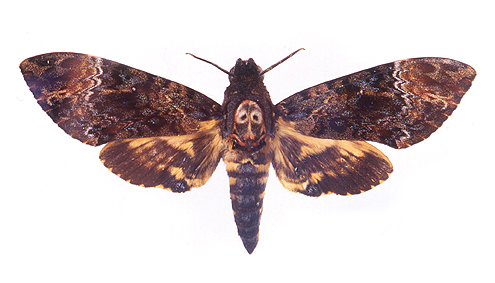Death's Head Sphinx Moth (Acherontia styx medusa)
Pricing: Dead (spread, as pictured): $75
Geographic Range: Most of Asia
View: Top View

Image Copyright 2003
Barbara Strnadova
This is the east Asian form of Acherontia styx , a powerful flier and wide-ranging migrant. It favors hot, open, low-lying country under semi-cultivation. Acherontia styx occurs as two subspecies; Acherontia styx medusa (pictured) and Acherontia styx styx. The core distributions of the two subspecies are as follows: A. s. medusa occurs throughout eastern continental Asia, from northeastern China and Japan, south through eastern China and Vietnam to Malaysia and Thailand. It is also found throughout the islands of the Malay Archipelago, from Sumatra, Borneo and the Philippines, east to the Moluccas. A. s. styx occurs from north-central and western China westward across northern Thailand, Burma (Myanmar), Bangladesh, India, Nepal, Pakistan and Iran to Saudi Arabia and Iraq. Separation of A. s. medusa from A. s. styx in China is problematic because the two subspecies appear to intermingle along a wide front. Although not a regular migrant, limited numbers are found each year as far north as Heilongjiang province. In both northeastern and southern China, there are two generations a year, with adults flying in May/June and August and larvae generally found from June until September. A fruit-piercer, and pest of yuzu (Citrus junos) in South Korea, it also loves honey (which is why it is also called "the bee robber". Eggs are pale green, changing to yellowish green just before hatching and are laid singly on leaves. Eggs usually hatch three to five days later. Newly hatched larvae are 5mm and yellowish green with a long, black, fork-tipped horn. In the second instar white lateral stripes and numerous small white tubercles appear. It is not until after the third molt that the final colors become apparent. Fully-grown larvae (90--120mm) closely resemble those of A. atropos except that the dark blue dorsal speckling is more pronounced on the anterior half of each abdominal segment, and the horn is less curved and lacks a reflexed tip. At 40°C, growth is exceedingly rapid, ovum to pupa taking as little as 10 days. Larval hostplants are Bignoniaceae, Fabaceae, Oleaceae, Pedaliaceae, Solanaceae and Verbenaceae, with occasional records from eleven other families.